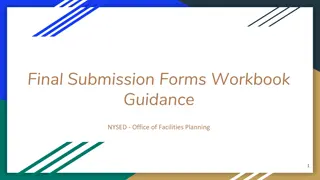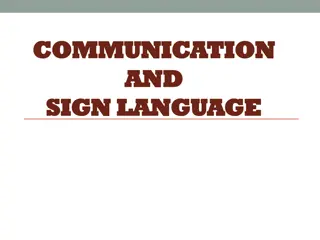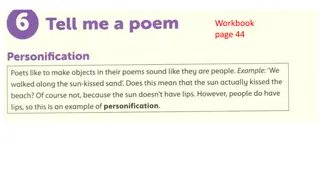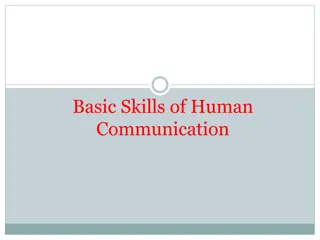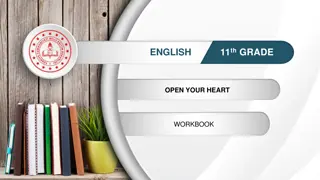Enhancing Business Communication Skills Workbook
Explore various aspects of business communication, from defining it to understanding challenges in today's dynamic workplaces. Learn about different types of communication at organizational levels and individual communication styles that can impact interactions. Improve communication effectiveness by reflecting on professional background and training experiences.
Download Presentation

Please find below an Image/Link to download the presentation.
The content on the website is provided AS IS for your information and personal use only. It may not be sold, licensed, or shared on other websites without obtaining consent from the author.If you encounter any issues during the download, it is possible that the publisher has removed the file from their server.
You are allowed to download the files provided on this website for personal or commercial use, subject to the condition that they are used lawfully. All files are the property of their respective owners.
The content on the website is provided AS IS for your information and personal use only. It may not be sold, licensed, or shared on other websites without obtaining consent from the author.
E N D
Presentation Transcript
Workbook 1 . Communication Skills Workbook E Gatawa
More tips on preparation Exercise Defining Business Communication
Defining Business Communication Reflecting on the training you have received and your professional background, provide your personal definition of business communication . . . . .... . . ....
Challenges in todays dynamic business communication Reflecting on your professional background, list business communication challenges you face in today s workplaces . . . .... . . ....
Types of Communication Organizational Level Communication in an organization occurs in multidimensional levels. Here are some types; Verbal Written Non verbal Digital Formal Informal Horizontal Vertical Cross functional External
Individual Communication Styles Assertive - Confidence of communicating without having to employ manipulation. In this style, one protects their own rights while being respectful of other people s rights and know how to express themselves socially and emotionally. Aggressive - This style involves winning, even if it is at someone else s expense. People who use this method usually feel like their needs are far much more important than that of others. Manipulative - This style is scheming, calculating and shrewd. People who impose this style are very skilled at controlling or influencing others for their own advantage.
Individual Communication Styles Passive/ Submissive - People who employ this style look to please other people and avoid any conflicts. People with this type of communication will put the needs of other before theirs because they see other people s needs as being more important than theirs. Passive Aggressive - This communication style involves being passive on the surface but actually acting out anger indirectly or behind the scenes. It s hypocritical and deceptive.
Individual Communication Styles Direct - This is a style where the speaker doesn t mask the message he wants to convey. This involves the use of clear language that can be easily understood by the recipient. Indirect - People employing this style tend to mask their intentions and needs. It is hard to know what they are looking to achieve. It can be hard for a person to decipher what they are trying to communicate, especially if they are not accustomed to a particular group or culture. This can sometimes employ the use of facial expressions or subtle signs.
Self Reflection In this intervention you will reflect on your past communication experiences and get a chance to assess yourself truthfully by relating to the previous Individual Communication Styles. We will also use a 360 degrees assessment/ multi source rater, where we will obtain assessment from your colleagues pertaining to your communication style(s).
Self Reflection Consider specific instances where you felt your communication was successful and when it could have been better. Try to identify patterns or recurring issues in your communication style. Complete the following on your own;
Exercise 1 Objectives of knowing yourself List the importance of knowing yourself in this exercise .
Exercise Lets get personal Intrapersonal Skills List how you communicate with yourself . List here Exercise 2
Exercise 3 Self Reflection Instance 1 ..................... Reaction .. What could you have done better ...........
Self Reflection Instance 2 ..................... Reaction .. What could you have done better ...........
Self Reflection Instance 3 ..................... Reaction .. What could you have done better ...........
Exercise 4 Introspection on your Communication Styles What is your Communication Style Communication Style(s) Characteristics
Exercise 5 360 degrees assessment on your Communication Styles What do others say about your Communication Style? This requires you to obtain feedback from 3 people who you work with. They can provide insights into your communication strengths and weaknesses that you might not be aware of. Encourage them to be honest and constructive in their assessments.
Respondent 1 360 degree Assessment on Communication Style for Participant Name . .. Dear Respondent Please name the participant s communication style, e.g, assertive, direct, indirect, passive, aggressive, manipulative and list their strengths and weaknesses. Further suggest recommendations on how they can communicate better. Communication Style(s) Characteristics (1) Strengths Weaknesses Recommendations
Respondent 2 360 degree Assessment on Communication Style for Participant Name . .. Dear Respondent Please name the participant s communication style, e.g, assertive, direct, indirect, passive, aggressive, manipulative and list their strengths and weaknesses. Further suggest recommendations on how they can communicate better. Communication Style(s) Characteristics (2) Strengths Weaknesses Recommendations
Respondent 3 360 degree Assessment on Communication Style for Participant Name . .. Dear Respondent Please name the participant s communication style, e.g, assertive, direct, indirect, passive, aggressive, manipulative and list their strengths and weaknesses. Further suggest recommendations on how they can communicate better. Communication Style(s) Characteristics (3) Strengths Weaknesses Recommendations
Exercise 6 How can you improve your communication style? After your own personal assessment and external assessment, identify what you consider the most effective communication type and its characteristics. Communication Type Characteristics
More tips on preparation Exercise 7 Personal Self-Assessment Framework
Self-Assessment Framework Create a Self-Assessment Framework Design a framework to evaluate your communication skills considering a scale of 1 to 5 (1 being the least and 5 being the most) using a checklist to rate your proficiency in each of the communication type aspects.
Self-Assessment Framework Aspect 1 2 3 4 5 Clarity Timeliness Empathy Assertiveness Active Listening Non Verbal Professionalism
Self-Assessment Framework Aspect 1 2 3 4 5 Organization Effective Feedback Cultural Sensitivity Team Collaboration Technical Proficiency Conciseness Confidentiality
Self-Assessment Framework Aspect 1 2 3 4 5 Respect Tone Grammar Follow up Technical Proficiency Self Reflection
Exercise 8 Assignment Utilizing the self-assessment provided above, elaborate on a strategy for enhancing communication across all outlined aspects within a maximum of 500 words.
Communication Skills Action Plan OBJECTIVES ASPECTS TO INCLUDE SUCCESS CRITERIA TIME FRAME RESOURCES (what do you want to achieve) (what aspects do you need to include) (how can you identify your success) (what is your dead line or time line) (what kind of resources or support do you need to achieve your success) Exercise 9


















